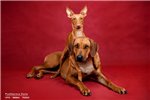Здравствуйте, гость ( Вход | Регистрация )
| Nana |
 16.5.2007, 8:37 16.5.2007, 8:37
Сообщение
#1
|
 Совет НКП    Группа: Пользователи Сообщений: 286 Регистрация: 2.8.2006 Из: Moscow Пользователь №: 10 |
We have just learned that the specific genetic mutation responsible for the ridge in the Rhodesian Ridgeback has been found.
The work was done by Dr. Leif Andersson at Uppsala University in Sweden in collaboration with researchers at the Broad Institute/MIT here in the U.S. and the Swedish University of Agricultural Sciences. A paper will be published in the coming months, and Dr. Andersson expects a genetic marker test to be available in the fall, pending licensure, etc. That is all the information Dr. Andersson has given us, along with his permission to disclose it to the Ridgeback community. We know you are as thrilled as we are. As many of you know, Dr. Mark Neff, in collaboration with RRCUS, was also searching in parallel for the same marker. While Dr. Neff's efforts were not responsible for this discovery, we all agree it is wonderful for the breed. We are sure this will be a subject of intense interest at Dr. Bell's seminar next Wednesday at the National Specialty in Ohio, as he will be discussing the implications of a direct-marker test for breeders. ============================================================== Коротко: Сотрудничество шведов и американцев привело к тому, что 23 мая на семинаре в Америке на Национальной выставке в Охайо будет объявлено о точном наследовании риджа и маркеровочных тестах. способных определить носителей. И т.д. |
  |
Ответов
| Nana |
 16.5.2007, 23:01 16.5.2007, 23:01
Сообщение
#2
|
 Совет НКП    Группа: Пользователи Сообщений: 286 Регистрация: 2.8.2006 Из: Moscow Пользователь №: 10 |
Было добавлено, что нет точных знаний, связывающих ДС и наличие риджа. Это только предположение, что некоторые составляющие риджа, к примеру завитки, связаны с ДС (волосы закручиваются спиралью внутрь, а не вверх). Этим также объясняется и наличие этого заболевания в других породах, которые также имеют завитки (кокеры или доберы). Также можно объяснить, почему безриджевые особи имеют иногда (реже, чем риджевые) это заболевание: они могут иметь ген (ы) , отвечающие за наследование завитков, но не риджа как такового.
Однако - всё это теория. To be clear, nobody is saying that there is a link between dermoids and homozygosity for the ridge. There is believed to be a link between dermoids and the presence of the ridge itself. There is one school of thought that says that some component of the ridge -- perhaps the crowns -- is connected to dermoids. (What is a dermoid, after all, but a crown that spirals downward instead of upward?) This also explains why dermoids, however uncommon, have been found on breeds that occasionally have whorling (i.e. cockers and Dobes). This also explains why ridgeless can have dermoids (though it is rare): They can inherit the gene(s) for crowns, but not the ridge gene which allows them to manifest. This is all theory, of course |
Сообщений в этой теме
 Nana Установлено точное наследование риджа 16.5.2007, 8:37
Nana Установлено точное наследование риджа 16.5.2007, 8:37
 KAI-DAUR Очень интересное сообщение!!! Будем жд... 16.5.2007, 10:39
KAI-DAUR Очень интересное сообщение!!! Будем жд... 16.5.2007, 10:39
 Irina Как далеко шагнула чужая наука... 16.5.2007, 13:43
Irina Как далеко шагнула чужая наука... 16.5.2007, 13:43
 Nana Пока ничего нового. Как и предполагалось, такой пр... 16.5.2007, 22:30
Nana Пока ничего нового. Как и предполагалось, такой пр... 16.5.2007, 22:30
 Irina Спасибо за информацию...Если можно и не сложно дай... 17.5.2007, 12:43
Irina Спасибо за информацию...Если можно и не сложно дай... 17.5.2007, 12:43
 ЭКЗОТИК ДОГ Большое спасибо, Nana, что открыли такую важную и ... 23.5.2007, 12:50
ЭКЗОТИК ДОГ Большое спасибо, Nana, что открыли такую важную и ... 23.5.2007, 12:50
 Nana Да, ЭКЗОТИК ДОГ, кошка у меня еще та тигра :) Она... 24.5.2007, 18:37
Nana Да, ЭКЗОТИК ДОГ, кошка у меня еще та тигра :) Она... 24.5.2007, 18:37
 Nana The MOI is single gene recessive. It is nonsyndrom... 25.5.2007, 11:36
Nana The MOI is single gene recessive. It is nonsyndrom... 25.5.2007, 11:36
 Nana http://cordis.europa.eu/fetch?CALLER=EN_NE...=... 4.10.2007, 21:10
Nana http://cordis.europa.eu/fetch?CALLER=EN_NE...=... 4.10.2007, 21:10
 Nana Добавлю из ссылки:
http://www.nature.com/ng/journa... 4.10.2007, 21:31
Nana Добавлю из ссылки:
http://www.nature.com/ng/journa... 4.10.2007, 21:31
 Nana В продолжение темы:
http://news.webindia123.com/ne... 5.10.2007, 18:58
Nana В продолжение темы:
http://news.webindia123.com/ne... 5.10.2007, 18:58
 Nana Собственник питомника Камелот (США) сделала статис... 6.10.2007, 10:54
Nana Собственник питомника Камелот (США) сделала статис... 6.10.2007, 10:54
 Nana Permission is given for this to be crossposted.
Да... 27.9.2008, 2:18
Nana Permission is given for this to be crossposted.
Да... 27.9.2008, 2:18
 bagrik ОГО... Наташ, а Кьяра и впрямь звезда :wub: И прям... 4.12.2009, 4:50
bagrik ОГО... Наташ, а Кьяра и впрямь звезда :wub: И прям... 4.12.2009, 4:50
 Interchampion
В данном случае, речь, к сожалению, идет о конкре... 7.12.2009, 15:28
Interchampion
В данном случае, речь, к сожалению, идет о конкре... 7.12.2009, 15:28

 Nana
Ну и коль речь уже пошла об оригиналах стандарта,... 7.12.2009, 23:49
Nana
Ну и коль речь уже пошла об оригиналах стандарта,... 7.12.2009, 23:49
 SH & Bonny Какой же я тупой! Не могу понять, что хочет ск... 7.12.2009, 19:48
SH & Bonny Какой же я тупой! Не могу понять, что хочет ск... 7.12.2009, 19:48
 bagrik Мдя....
Цитирую:)
"Ну, где же Вы увидели аг... 8.12.2009, 3:50
bagrik Мдя....
Цитирую:)
"Ну, где же Вы увидели аг... 8.12.2009, 3:50
 Администратор Сообщение Jeremy перемещено.
http://www.ridgeback.... 8.12.2009, 15:02
Администратор Сообщение Jeremy перемещено.
http://www.ridgeback.... 8.12.2009, 15:02
 Jeremy А также задать вопрос г-же Президенту:
"Почем... 8.12.2009, 19:13
Jeremy А также задать вопрос г-же Президенту:
"Почем... 8.12.2009, 19:13
 oxana
Кто из присутствующих вообще видит смысл в монопо... 8.12.2009, 19:22
oxana
Кто из присутствующих вообще видит смысл в монопо... 8.12.2009, 19:22  |
2 чел. читают эту тему (гостей: 2, скрытых пользователей: 0)
Пользователей: 0
|
|
Текстовая версия | Сейчас: 29.7.2025, 1:44 |
Русская версия Invision Power Board
v2.1.7 © 2025 IPS, Inc.
Лицензия зарегистрирована на: Национальный клуб РОДЕЗИЙСКИЙ РИДЖБЕК








